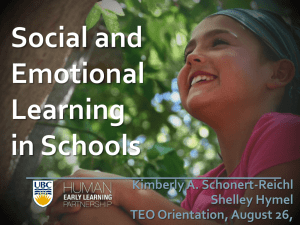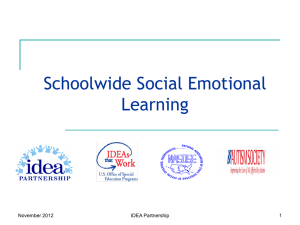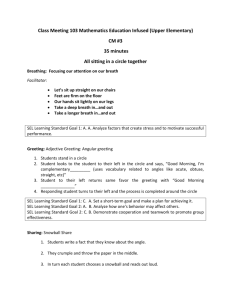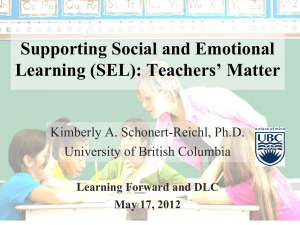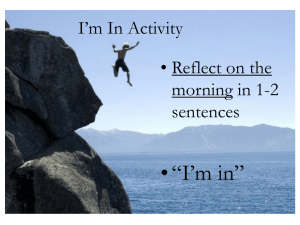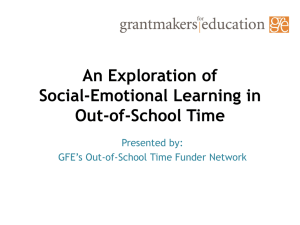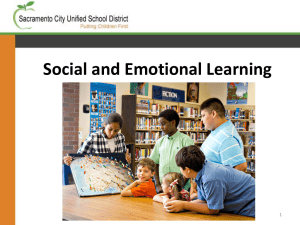SEL - Pathways To Resilience Trust
advertisement
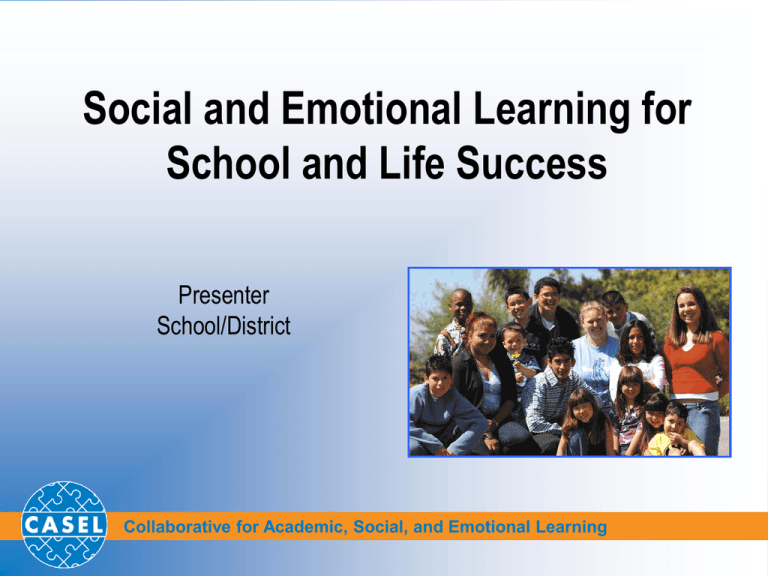
Social and Emotional Learning for School and Life Success Presenter School/District Collaborative for Academic, Social, and Emotional Learning A Vision for Our School The vision of the … School is to maintain a creative climate wherein all students can develop intellectually, emotionally, artistically, and socially to their fullest potential. As a result, students will experience the joy of learning, academic growth, arts exploration and acquire the skills that exemplify responsible citizenship. Reflection Question: What knowledge, skills, and qualities do students need to possess by the time they graduate from high school? Social and Emotional Learning (SEL) SEL is the process whereby children and adults develop essential social and emotional skills, knowledge, and attitudes related to: Recognizing one’s emotions and values as well as one’s strengths and limitations Managing emotions and behaviors to achieve one’s goals Selfawareness Selfmanagement SEL Showing understanding and empathy for others Social awareness Making ethical, constructive choices about personal and social behavior Responsible decisionmaking Relationship skills Forming positive relationships, working in teams, dealing effectively with conflict Illinois State Board of Education SEL Goals 31) Develop self-awareness and self-management skills to achieve school and life success 32) Use social awareness and interpersonal skills to establish and maintain positive relationships 33) Demonstrate decision-making skills and responsible behaviors in personal, school, and community contexts Source: http://www.isbe.state.il.us/ils/social_emotional/standards.htm How Do You Promote Social and Emotional Competency? Skill development Providing explicit skills instruction for all students Learning environment Creating safe, caring, well-managed learning environments Why Promote Students’ Social and Emotional Competency? Students who receive SEL instruction are: • more connected to teachers and school • more engaged in learning • more motivated to learn • more well behaved/less likely to engage in problem behavior • able to perform better on achievement tests and get better grades Source: Zins, Weissberg, Wang, & Walberg (2004). Building Academic Success on Social and Emotional Learning (SEL): What Does the Research Say? SEL Improves Academic Outcomes • 23% increase in skills • 9% improvement in attitudes about self, others, and school • 9% improvement in prosocial behavior • 9% reduction in problem behaviors • 10% reduction in emotional distress • 11% increase in standardized achievement test scores (math and reading) Source: Durlak, J.A., Weissberg, R.P., Taylor, R.D., & Dymnicki, A.B. (submitted for publication). The effects of school-based social and emotional learning: A meta-analytic review. SEL Teaches • • • • • • • st 21 Century Skills Critical thinking and problem-solving Ethics and social responsibility Communication Teamwork and collaboration Lifelong learning and self-direction Leadership Global awareness Source: Partnership for 21st Century Skills How Does SEL Lead to Student Success? Evidence-based SEL Programming Inputs Effective Learning Environments: • Safe • Caring • Well-managed • Engaging • Supportive • High Expectations SE Skills Instruction: • Self-awareness • Self-management • Social awareness • Relationship skills • Responsible decisionmaking Proximal Outcomes Greater Attachment, Engagement and Commitment to School Less Risky Behavior, More Positive Development Distal Outcomes Greater Success in School, Work, and Life How Does SEL Fit with What We’re Already Doing? Prevention Programming SEL Can Be a Coordinating Framework Where Do We Go from Here? Professional Development Communication 1. Principal commits 2. Form steering committee Evaluation 3. Articulate shared vision 10. Continue to improve integration 4. Conduct assessment Leadership 9. Integrate SEL schoolwide Family & Community Partnerships 5. Develop action plan 8. Launch SEL in classrooms 7. Conduct staff development Integration 6. Select program Infrastructure Our Next Steps • Form a steering committee. • Share information about SEL with our entire school community. • Schedule staff meeting time to discuss SEL. • Plan a student assembly to introduce students to SEL. • Discuss SEL competency integration at department/team meetings. Summary • SEL is the process whereby children and adults develop essential social and emotional competencies. • SEL competency is the foundation to positive academic, social, emotional, health, and civic outcomes. • SEL is not separate from, but integral to, quality education and the mission of schools. • SEL is an essential part of the 21st century curriculum! For more information about SEL, please visit: www.casel.org


